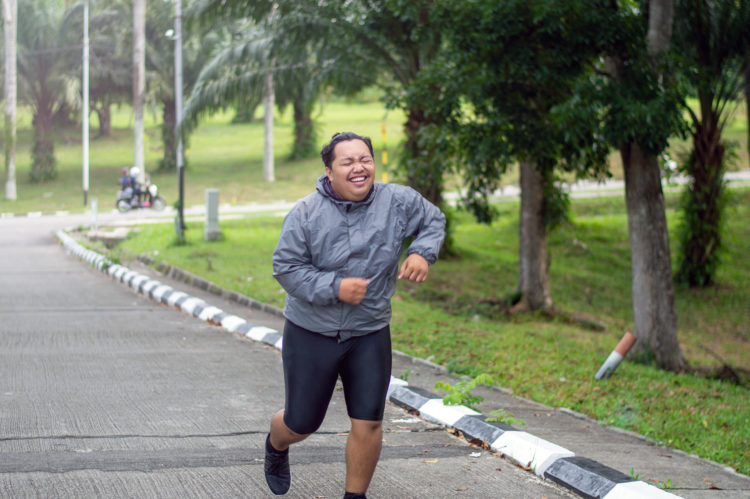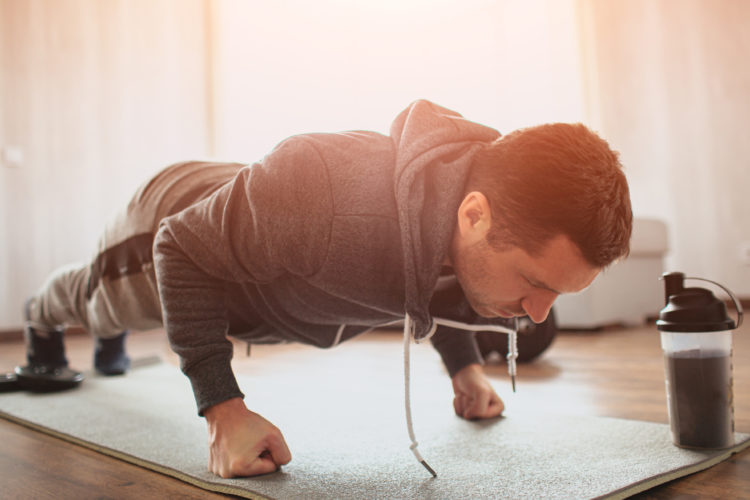Editor’s note: This article is an op-ed. The views expressed herein and in the video are the author’s and don’t necessarily reflect the views of BarBend. Claims, assertions, opinions, and quotes have been sourced exclusively by the author.
I just recently made a trip to get groceries. It was weird.
I had been sheltered indoors for days on end, and when I went outside, I discovered that spring weather had begun to roll in, as a gentle and refreshing breeze kissed the bridge of my nose just about my facemask.
As I made my way to the grocery store, I drove along one deserted street after another. It started to feel like a scene from the Walking Dead, and just as I was beginning to expect to see some mindless zombies, I spotted zealous joggers.
And then I saw more joggers. And then more. I must have seen at least a dozen joggers, many running in pairs, by the time I made it to the grocery store. I just thought, why?
The conventional answer is that jogging is good for you. But, is it?
Running is optimal for getting better at running. Jogging may be good for cardiovascular health, up to a point. And, it may be conducive to mental hygiene for some.
But does jogging build muscle? Strengthen joints? Promote and preserve bone density?
With gyms across the nation closing indefinitely due to the COVID-19 situation, many people think — and may even feel obligated — to take up running to stay fit. Here are some reasons to rethink that idea.

Running isn’t necessary in order to do “cardio”
Although it’s admirable to pursue and maintain heart health, you don’t need to go out running for thirty-plus minutes to do it. Dust off those vinyl coated dumbbells you bought at that garage sale back in 2003, clear eight square feet in your living room, and get creative.
Hit things like dumbbell squats, goblet squats, squat thrusters, Bulgarian split squats, lunges, step-ups, rows, flies, lat raises, flat presses, overhead presses — and yes, all varieties of curls. Do these movements in sets with high volume, like twenty reps, or even AMRAPS. Limit rest periods to one to two minutes between sets. Do circuits, and add tempos to your movements. Ensure that you use full ranges of motion each time. Throw in bodyweight exercises like pushups and leglifts. And guess what — you’re doing cardio.
[Related: 7 single dumbbell workouts you can do anywhere, any time]
However, you’re not just doing cardio. You’re also doing hypertrophy training, which helps maintain and grow muscle, creating a good foundation for strength development for when we can all get back to doing barbell work.
People often confuse endurance training with cardio training. The former, which can be achieved when racking up miles on the road or treadmill, stimulates a particular physiological adaptation. If you plan to run a marathon, half marathon, or even a 5k, you need endurance. You don’t need endurance training in order to promote “cardio” though. Successive sets of high reps even at low weights can make your heart feel like it’s going to beat out of your chest, except unlike endurance training, the hypertrophic effects of high volume lifting will preserve and build muscle rather than diminish it.
[Related: 4 household items that can double as fitness equipment]

Jogging isn’t necessarily good for you
People underestimate jogging, thinking it’s like walking but a bit faster. Not so. Pounding the pavement takes a toll on the joints. Admittedly, the risk of running carries a relatively low risk of an acute injury, provided you look both ways before crossing the street.
But up to 79 percent of runners get sidelined with an injury at least once a year. The repeated impact of step-after-step, mile-after-mile, day-after-day can invite a repetitive stress injury. This occurs while also bearing the opportunity cost of forgoing modes of physical activity more optimal to your overall health, like hypertrophic weight training. (That injury rate can also be partly explained by the fact that a lot of runners neglect full ROM, injury preventing resistance training.)

Running on the streets isn’t staying indoors
Based on what we currently know of COVID-19, social distancing is a key way to guard against contracting and spreading it. While it may well be the case that a gust of wind will whisk away COVID-19 germs, the science is apparently unsettled on this. While it remains conceivable that you can contract or transmit COVID-19 to a nearby jogger or bystander, you know where you cannot get or give COVID-19? Your living room. Stay indoors.
[Related: 8 muscle-building home workouts from top athletes and coaches]
Jogging isn’t a substitute for good nutrition
It’s easy to go a bit stir-crazy in the midst of the Coronavirus restrictions, and it is important to avoid becoming sedentary, especially given that our commutes to work have been reduced to a trip from the bed to the couch. It’s also critical to remember that a major factor in determining body weight and composition is our nutrition, and going out for a run will not compensate for you burning through those bags of non-perishable pretzels you might have recently crammed into your kitchen cupboards.
Although many seem to think that “cardio” — by which they often actually mean endurance exercises — is necessary to losing or at least maintaining body weight, caloric balance is in actuality the primary driver. So, instead of hitting the road for however many miles it takes to burn 500 calories daily, opt instead to simply eat 500 calories fewer per day. It takes a lot less time, is much easier on the joints, and leaves you with greater opportunities to lift some weights. (Which, when done in a manner that keeps the heart rate elevated, is just as great at burning calories.)
[Related: The best streaming services for home workouts]

Wrapping it up
If you’re an athlete whose sport requires endurance, then by all means, train for endurance. And of course, make sure that you do so with proper technique.
Also, for the time being, be mindful of keeping at least six feet away from anyone else.
If you’re just someone who wants to get or stay fit, or even a strength athlete who has been displaced because the COVID-19 restrictions forced your gym to close, don’t run. Focus on high volume resistance training with whatever tools are at your disposal, keep your nutrition on point, and set the stage for strength gains to really happen when our beloved gyms reopen.
Featured image via Carlos Pintau/Shutterstock